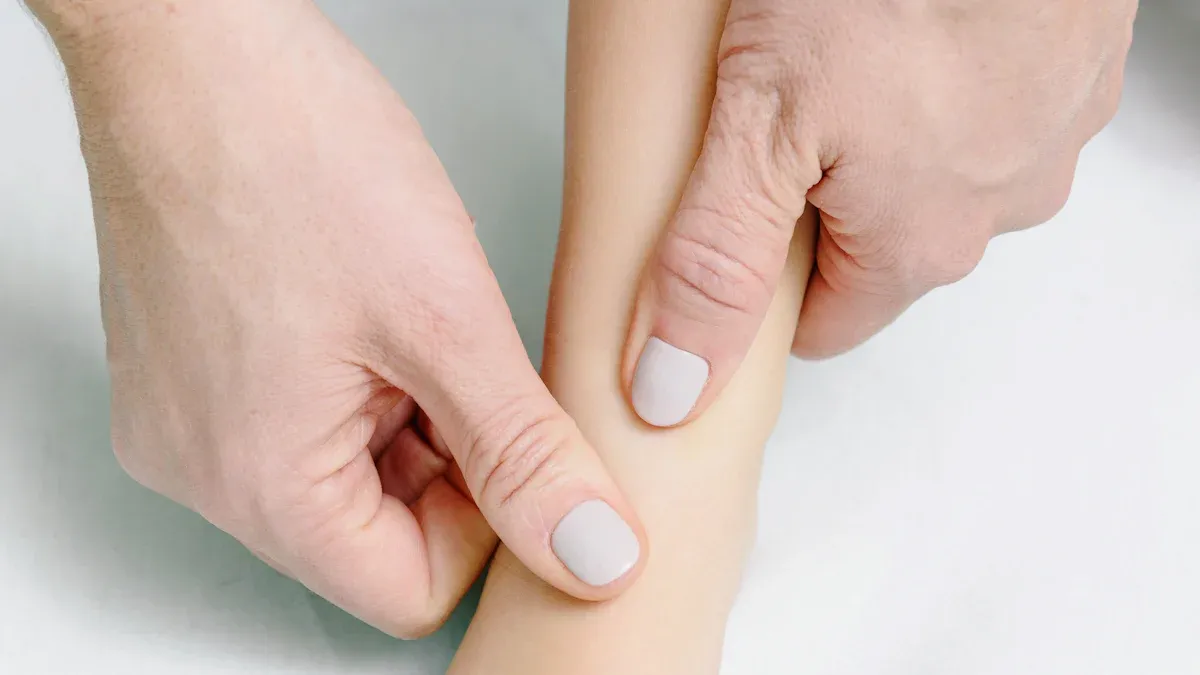Top 7 Self-Care Tips for Managing Lymphedema Every Day

Living with lymphedema can feel overwhelming, but small, consistent self-care actions make a big difference. Simple habits like moderate exercise reduce swelling and improve mobility. Research even shows that lifestyle adjustments, like balanced nutrition, enhance physical and emotional well-being. Managing Lymphedema: Tips for Daily Life starts with these small, impactful changes.
Key Takeaways
Wash and moisturize your skin every day to avoid infections and keep it healthy.
Use compression clothes as your doctor suggests to lower swelling and feel better; stick to it daily.
Do gentle exercises like walking or swimming to help your body’s lymph flow and stay healthy.
Managing Lymphedema: Tips for Daily Life
Keep the skin clean and moisturized
Taking care of your skin is one of the most important steps in managing lymphedema. Clean the affected area daily with warm, soapy water to remove dirt and bacteria. Avoid soaps that dry out your skin, as they can cause cracks or irritation. After washing, pat your skin dry gently—don’t rub! Then, apply a moisturizer to keep your skin hydrated and healthy. Regular moisturizing helps maintain your skin’s integrity and prevents dryness, which could lead to complications.
Did you know that people with lymphedema are at a higher risk of infections? That’s why keeping your skin clean and moisturized isn’t just about comfort—it’s about protection. By doing this daily, you reduce the chances of bacteria entering through small injuries.
Protect against cuts, scrapes, and infections
Your skin is your first line of defense, so protecting it is key. Even small cuts or scrapes can lead to infections, especially if you have lymphedema. To avoid injuries, trim your nails carefully, wear gloves when gardening, and use sunscreen to prevent burns. If you do get a cut, clean it immediately and apply an antibiotic ointment to reduce the risk of infection.
Injuries can trigger swelling and inflammation, making lymphedema worse. Taking precautions, like wearing protective clothing or avoiding sharp objects, can save you from unnecessary complications.
Use gentle, fragrance-free products
When it comes to skincare, less is more. Choose gentle, fragrance-free products to avoid irritating your skin. Harsh soaps or lotions with strong scents can cause dryness or allergic reactions, which may lead to cracks or infections. Products like Lymphoderm Lotion are specifically designed to be safe for sensitive skin.
By sticking to mild, fragrance-free options, you’re giving your skin the care it needs without added risks. This small change can make a big difference in managing lymphedema symptoms.
Use Compression Therapy Effectively
Wear compression garments as prescribed
Compression garments are a cornerstone of managing lymphedema. They apply gentle pressure to help move fluid through your lymphatic system, reducing swelling and discomfort. Doctors or lymphedema specialists prescribe these garments based on your specific needs. It’s important to follow their instructions carefully. For example, daytime garments should not be worn while sleeping, as they’re designed for active use.
Tip: Make wearing your compression garment part of your daily routine. Consistency is key to seeing results.
Studies show that compression therapy, including garments and pneumatic devices, effectively reduces swelling and improves symptoms. A 2016 study even found that night-time compression bandaging helped women with breast cancer-related lymphedema sleep better.
Ensure proper fit and maintenance of garments
A well-fitted compression garment makes all the difference. It should feel snug but never restrictive. Accurate body measurements are essential, so don’t hesitate to ask your specialist for help. To maintain elasticity, wash your garment with mild detergent, avoid fabric softeners, and air dry it. Proper care ensures your garment lasts longer and works effectively.
Note: Store your garment in a cool, dry place and fold it instead of hanging to prevent stretching.
Consult a specialist for adjustments if needed
If your garment feels uncomfortable or stops fitting properly, consult a specialist. They can adjust the fit or recommend a new garment tailored to your needs. Healthcare providers can also guide you on how to use compression therapy as part of a broader treatment plan, including exercise and lifestyle changes.
Regular check-ins with your specialist ensure your garment continues to support your recovery and comfort.
Stay Active with Low-Impact Exercise

Staying active is one of the best ways to manage lymphedema and improve your overall well-being. Low-impact exercises like walking or swimming can help keep your lymphatic system moving without putting too much strain on your body. Let’s explore how you can incorporate movement into your daily routine.
Incorporate activities like walking or swimming
Walking is a simple yet effective way to support lymphatic flow. Start with a short walk, around 3 to 10 minutes, to warm up your muscles and encourage lymph drainage. Swimming or water-based exercises are also fantastic options. The natural pressure of water, known as hydrostatic pressure, gently massages your body, reducing swelling and improving circulation. Plus, water exercises are easy on your joints and reduce the risk of injury.
Tip: Choose activities you enjoy, like yoga or resistance training, to stay motivated. Gradually increase the intensity and duration of your workouts while wearing your compression garment for added support.
Practice lymphatic drainage exercises
Lymphatic drainage exercises are designed to stimulate lymph flow and reduce swelling. These exercises often involve gentle, repetitive movements that target specific areas of your body. For example, arm circles or ankle pumps can help improve circulation in your limbs. Research shows that regular sessions of manual lymphatic drainage can significantly reduce swelling and improve mobility.
Exercise Type | Benefit |
|---|---|
Arm Circles | Improves upper limb circulation |
Ankle Pumps | Enhances lymph flow in the lower limbs |
Water-Based Exercises | Reduces edema and supports lymph nodes |
Avoid overexertion and listen to your body
While exercise is beneficial, it’s important not to overdo it. Pay attention to how your body feels during and after physical activity. If you notice increased swelling or discomfort, take a break and consult your healthcare provider. Regular physical activity should leave you feeling energized, not exhausted.
Remember, managing lymphedema is about balance. By staying active with low-impact exercises, you can support your lymphatic system and improve your quality of life.
Support Your Body with Nutrition and Hydration

Eat a balanced diet with anti-inflammatory foods
What you eat plays a big role in managing lymphedema. A balanced diet packed with anti-inflammatory foods can help reduce swelling and support your lymphatic system. Omega-3 fatty acids are especially helpful because they fight inflammation and boost your immune system. You can find these in foods like salmon, walnuts, chia seeds, and flax seeds.
Tip: Add turmeric and garlic to your meals. They’re not just flavorful—they’re also known for their anti-inflammatory properties!
Research shows that diets like the ketogenic diet, which focus on reducing carbohydrates, can improve lymphedema symptoms. On the flip side, high-carb diets, especially those with lots of fructose, can harm lymphatic health. Choosing healthy fats like olive oil or flaxseed oil over processed options can make a big difference.
Food Type | Examples | Benefit |
|---|---|---|
Omega-3 Rich Foods | Salmon, walnuts, chia seeds | Reduces inflammation |
Healthy Fats | Olive oil, flaxseed oil | Supports lymphatic health |
Anti-inflammatory | Turmeric, garlic | Helps reduce swelling |
Limit salt intake to reduce fluid retention
Too much salt can make your body hold onto extra fluid, which worsens swelling. Cutting back on salty snacks and processed foods can help you manage lymphedema symptoms. Instead, season your meals with herbs and spices for flavor without the added sodium.
Stay hydrated throughout the day
Drinking enough water might seem counterintuitive when dealing with swelling, but it’s essential. Dehydration can cause your body to retain fluids, making symptoms worse. Staying hydrated helps your lymphatic system filter and remove waste effectively.
Note: Avoid diuretics like coffee and alcohol, as they can dehydrate you. Stick to water or herbal teas to keep your body balanced.
By eating well, limiting salt, and staying hydrated, you’re giving your body the tools it needs to manage lymphedema and feel its best.
Reduce Stress and Practice Relaxation
Stress can make managing lymphedema harder. It affects your body and mind, often worsening symptoms. Taking time to relax and reduce stress isn’t just a luxury—it’s essential for your health. Let’s explore a few ways you can bring more calm into your daily routine.
Try mindfulness techniques like meditation or deep breathing
Mindfulness techniques, like deep breathing, can work wonders for stress relief. These exercises help you focus on the present moment, calming your mind and body. Deep breathing, in particular, has been shown to reduce anxiety and improve mood. It’s simple to try—just inhale deeply through your nose, hold for a few seconds, and exhale slowly through your mouth.
Research highlights how stress from body image concerns or feeling out of control can impact lymphedema patients. Mindfulness helps you regain that sense of control. Even a few minutes a day can make a big difference in how you feel.
Technique | Impact on Lymphedema Symptoms |
|---|---|
Improves stress resilience and overall health | |
Time management strategies | Reduces chronic stress levels |
Calming music | Enhances mood and reduces anxiety |
Breathing exercises | More effective than mindfulness meditation in reducing anxiety and improving mood |
Engage in hobbies or activities that bring joy
Doing things you love can help you unwind and recharge. Whether it’s painting, gardening, or reading, hobbies give you a break from the daily demands of managing lymphedema. Chronic stress often stems from tasks like wearing compression garments or sticking to a self-care routine. Joyful activities help you shift focus and build resilience.
Relaxation exercises and calming music can soothe your nervous system.
Hobbies reduce physiological stress responses, helping you feel more in control.
Activities you enjoy can improve your mood and overall outlook.
So, pick up that paintbrush or dive into a good book. It’s not just fun—it’s therapy!
Seek support from friends, family, or support groups
You don’t have to manage lymphedema alone. Leaning on your support network can make a huge difference. Family and friends can provide emotional encouragement and help you stick to your treatment plan. In some cases, trained family members can even assist with hands-on care.
Support groups are another great option. Connecting with others who understand your challenges can be incredibly empowering. Sharing experiences and tips can help you feel less isolated and more motivated.
Family and friends offer emotional support and motivation.
Community involvement strengthens your care routine.
Support groups create a safe space to share and learn.
By building a strong support system, you’ll feel more confident and capable in managing your condition.
Wear Comfortable Clothing and Maintain Posture
Choose loose, non-restrictive clothing
What you wear can have a big impact on managing lymphedema. Tight clothing can restrict fluid flow, making swelling worse. Instead, opt for loose, comfortable garments that allow your body to move freely. Soft, breathable fabrics like cotton or bamboo are great choices. They’re gentle on your skin and won’t cause irritation.
Loose clothing helps prevent constriction of fluid flow.
Tight garments can impede circulation and worsen symptoms.
Choosing comfortable outfits supports better lymphatic health.
Tip: Look for clothing with elastic-free waistbands or adjustable features. These small changes can make a big difference in how you feel throughout the day.
Avoid tight jewelry or accessories
Even small things like jewelry can affect your lymphatic system. Rings, bracelets, or watches that fit too tightly can block lymphatic drainage. This can lead to increased swelling in the affected areas. Shoes with tight straps or laces can have a similar effect on your feet and ankles.
To avoid these issues, choose accessories that fit loosely or skip them altogether when possible. For footwear, look for options with soft, flexible materials that don’t press against your skin.
Tight jewelry and shoes can decrease lymphatic drainage.
Looser accessories reduce the risk of swelling and discomfort.
Note: If you notice any marks or indentations on your skin after wearing jewelry or shoes, it’s a sign they’re too tight.
Practice good posture to support lymphatic flow
Did you know that standing or sitting with good posture can help your lymphatic system? Keeping your back straight and your shoulders relaxed allows lymph fluid to flow more freely. Slouching or staying in one position for too long can slow this process down.
Make it a habit to check your posture throughout the day. When sitting, keep your feet flat on the floor and avoid crossing your legs. If you’re standing, distribute your weight evenly on both feet. Walking regularly also helps stimulate lymphatic flow.
Good posture improves lymphatic circulation.
Standing tall and moving often supports better fluid drainage.
Reminder: Set a timer to stretch or adjust your posture every hour. Small adjustments can make a big difference in managing lymphedema.
Prioritize Rest and Elevation
Elevate the affected limb while sleeping
Elevating your affected limb while you sleep can make a noticeable difference in managing lymphedema. By raising the limb above heart level, you help gravity reduce fluid buildup, which minimizes swelling. You can use pillows or a wedge cushion to keep the limb comfortably elevated throughout the night.
Studies back this up. For example:
Study Year | Findings | Details |
|---|---|---|
2016 | Night-time compression helps with sleep disturbances | Women with breast cancer-related lymphedema reported benefits from compression garments during sleep. |
2018 | Custom-made compression garments improve sleep quality | Participants found the garments comfortable and noted better sleep quality. |
N/A | Elevation and compression reduce swelling | 89% of participants indicated that swelling increased without night compression. |
If you’re not already elevating your limb, give it a try. It’s a simple change that can bring big relief.
Create a calming bedtime routine
A relaxing bedtime routine can set the stage for better sleep and improved lymphedema management. Small changes, like dimming the lights or listening to calming music, can help you unwind. Relaxation exercises, such as deep breathing or guided imagery, are also great options.
Here are some tips to create a soothing sleep environment:
Adjust the room temperature to a comfortable level.
Use blackout curtains or an eye mask to block out light.
Try white noise or soft music to drown out distractions.
Dr. Keith, a lymphedema expert, highlights how sleep disruptions are common for people with lymphedema. By focusing on relaxation and comfort, you can improve your sleep quality and feel more refreshed.
Ensure adequate rest to support overall health
Getting enough rest isn’t just about feeling less tired—it’s essential for your overall health. Sleep helps your body repair itself, boosts your immune system, and supports your lymphatic system. During sleep, your lymphatic system works harder to remove waste and distribute nutrients, which is crucial for managing lymphedema.
Evidence Description | Impact on Health |
|---|---|
Healthy sleep is essential for overall health, affecting cognition, mood, energy, immune functions, hormonal balance, and cardiovascular health. | Adequate rest is crucial for lymphedema patients to maintain these health aspects, which are vital for managing their condition. |
The lymphatic system, including glymphatics in the brain, is more active during sleep, aiding in nutrient distribution and waste removal. | This highlights the importance of sleep for lymphatic function, which is critical for lymphedema management. |
Prioritizing rest gives your body the time it needs to heal and recharge. So, aim for a consistent sleep schedule and make rest a non-negotiable part of your self-care routine.
Managing lymphedema starts with small, consistent actions. By following these seven tips, you can reduce swelling, improve mobility, and feel more in control.
A holistic self-care routine boosts physical and emotional health.
Relaxation techniques and time management reduce stress and improve your quality of life.
Start today—your future self will thank you!
FAQ
What should I do if my compression garment feels uncomfortable?
If your garment feels tight or causes discomfort, consult your specialist. They can adjust the fit or recommend a new one tailored to your needs.
Can I exercise without wearing my compression garment?
You should wear your compression garment during exercise unless your doctor advises otherwise. It provides support and helps manage swelling while you stay active.
How often should I moisturize my skin?
Moisturize your skin daily, especially after washing. This keeps it hydrated and reduces the risk of dryness or cracks that could lead to infections.
See Also
Exploring Symptoms And Therapies For Lymphomatoid Granulomatosis
An Insight Into Symptoms And Care For LGL Leukemia
Recognizing Symptoms And Options For Conjunctival Melanoma
